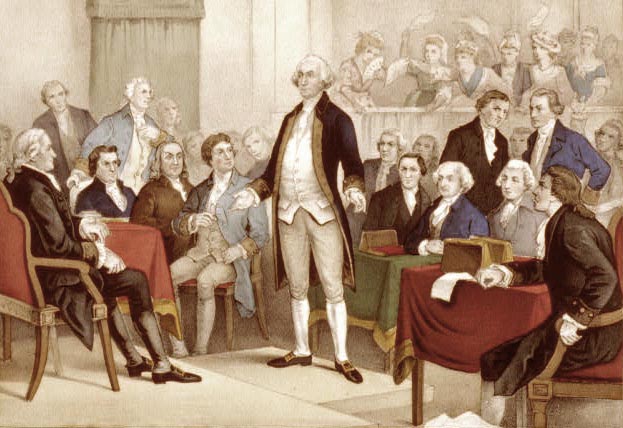From Rebellion:
4:59 PM (45 minutes ago)What is marriage?from feed/http://www.dixienet.org/rebellion/atom.xml by Old RebelOnly small-minded Neanderthals oppose same-sex marriage. Worse, they have no valid reasons for doing so -- it all comes down to mere prejudice.
Right? Everyone knows there's nothing wrong with "gay" marriage -- newspaper editors, Hollywood celebrities, the Southern Poverty Law Center -- you know, everyone.
Well, here's a scholarly presentation of the conservative case for traditional marriage written by a philosopher and two political scientists. It's lengthy and comprehensive, so here are the main points:
1. Comprehensive Union
Marriage is distinguished from every other form of friendship inasmuch as it is comprehensive. It involves a sharing of lives and resources, and a union of minds and wills—hence, among other things, the requirement of consent for forming a marriage. But on the conjugal view, it also includes organic bodily union. This is because the body is a real part of the person, not just his costume, vehicle, or property. Human beings are not properly understood as nonbodily persons—minds, ghosts, consciousnesses—that inhabit and use nonpersonal bodies. After all, if someone ruins your car, he vandalizes your property, but if he amputates your leg, he injures you. Because the body is an inherent part of the human person, there is a difference in kind between vandalism and violation; between destruction of property and mutilation of bodies.
Likewise, because our bodies are truly aspects of us as persons, any union of two people that did not involve organic bodily union would not be comprehensive—it would leave out an important part of each person’s being. Because persons are body‐mind composites, a bodily union extends the relationship of two friends along an entirely new dimension of their being as persons. If two people want to unite in the comprehensive way proper to marriage, they must (among other things) unite organically—that is, in the bodily dimension of their being. ...
By extension, bodily union involves mutual coordination toward a bodily good—which is realized only through coitus. And this union occurs even when conception, the bodily good toward which sexual intercourse as a biological function is oriented, does not occur. In other words, organic bodily unity is achieved when a man and woman coordinate to perform an act of the kind that causes conception. This act is traditionally called the act of generation or the generative act; if (and only if) it is a free and loving expression of the spouses’ permanent and exclusive commitment, then it is also a marital act. ...
2. Special Link to Children
Most people accept that marriage is also deeply—indeed, in an important sense, uniquely—oriented to having and rearing children. That is, it is the kind of relationship that by its nature is oriented to, and enriched by, the bearing and rearing of children. But how can this be true, and what does it tell us about the structure of marriage?
It is clear that merely committing to rear children together, or even actually doing so, is not enough to make a relationship a marriage — to make it the kind of relationship that is by its nature oriented to bearing and rearing children. If three monks agreed to care for an orphan, or if two elderly brothers began caring for their late sister’s son, they would not thereby become spouses. It is also clear that having children is not necessary to being married; newlyweds do not become spouses only when their first child comes along. Anglo‐American legal tradition has for centuries regarded coitus, and not the conception or birth of a child, as the event that consummates a marriage. Furthermore, this tradition has never denied that childless marriages were true marriages. ...
3. Marital Norms
Finally, unions that are consummated by the generative act, and that are thus oriented to having and rearing children, can make better sense of the other norms that shape marriage as we have known it. ...
Thus, the inherent orientation of conjugal union to children deepens and extends whatever reasons spouses may have to stay together for life and to remain faithful: in relationships that lack this orientation, it is hard to see why permanence and
exclusivity should be, not only desirable whenever not very costly (as stability is in any good human bond), but inherently normative for anyone in the relevant kind of relationship.
A homosexual advocate responds here. And the authors counter very effectively in this article.
The Best Argument Against Gay Marriage
And why it fails.
By Kenji Yoshino
Posted Monday, Dec. 13, 2010, at 4:34 PM ET
How strong is the strongest argument against gay marriage?In last week's arguments in Perry v. Schwarzenegger, the California same-sex marriage case, it was clear that the main secular argument for limiting marriage to opposite-sex couples is the "common procreation" rationale. The idea is that marriage is properly limited to opposite-sex couples because they, and only they, can engage in procreation within their union. The lawyers defending California's gay marriage ban, Proposition 8, did not fully elaborate the argument—the New York Times editorial page called it a "tired, and thoroughly specious, assertion."
PRINT
DISCUSS
E-MAIL
RSS
RECOMMEND...
REPRINTS
SINGLE PAGE
Facebook Digg RedditStumbleUponCLOSENow conservative blogs are celebrating—as "one of the best arguments" and "outstanding work"—the more fulsome defense of the common procreation argument made in a forthcoming article by Sherif Girgis, Robert P. George, and Ryan T. Anderson. Yet the article's more comprehensive elaboration of the argument reveals why the Proposition 8 defenders were right not to shine too bright a light on it. Closely examined, the common-procreation argument denigrates not only same-sex couples but several kinds of married opposite-sex couples.
Princeton professor Robert George is a conservative heavyweight in debates over same-sex marriage. With two graduate student co-authors, he claims to have revealed the true nature of marriage. The article argues for common procreation as the sole basis for a "real" or "conjugal" marriage by asserting that only a man and a woman can create a "comprehensive union." In defining that special status, the authors begin by drawing a distinction between "sexual" exclusivity and "tennis" exclusivity: "Suppose that Michael and Michelle build their relationship not on sexual exclusivity, but on tennis exclusivity. They pledge to play tennis with each other, and only with each other, until death do them part. Are they thereby married? No." While the purpose of this distinction is initially mystifying, the authors are making a serious point. They are contending that sexual activity has been privileged over other kinds of bonding activities in determining who gets to marry.
George and his co-authors continue, however, to observe that not all sexual activity counts as a basis for marriage—what is required is sexual activity capable of producing a child. The article infers this requirement from the physical makeup of men and women. Because same-sex couples cannot create this child-producing combination by themselves, their relationship is a recreational activity more like tennis than like marriage.
Advertisement
But mark the sequel—if a prerequisite of marriage is procreative capacity, then are the marriages of infertile opposite-sex couples not called into question? George and his co-authors are quick to reassure with another sports analogy: "A baseball team has its characteristic structure largely because of its orientation to winning games; it involves developing and sharing one's athletic skills in the way best suited for honorably winning. … But such development and sharing are possible and inherently valuable for teammates even when they lose their games." In other words, infertile couples are still playing ball, even if they never win a game. They are the Phillies, except that they have no hope of ever improving.
I suspect it will be cold comfort to many infertile opposite-sex couples to hear that while their marriage is still "real," it is a "losing" marriage as opposed to a "winning" one. Ideally, most of them view their marriages as something more than honorable defeats and would despise the contention that they had not fulfilled the central purpose of the institution. Moreover, the article says nothing of straight people who choose not to procreate. It is unclear why they would have "true marriages," as they are not even trying to win.
George's second argument for the centrality of common procreation to marriage is the special link that parents have to children. He and his co-authors rely on the research institution Child Trends for the proposition that "it is not simply the presence of two parents … but the presence of two biological parents that seems to support children's development." This source, like many cited by the opponents of same-sex marriage, does not compare the children raised by two biological parents with the children raised by two same-sex parents. Instead, the research compares children raised by two biological parents with children raised by single parents, divorced couples, and cohabiting straight couples. The study simply has nothing to do with gay adoption. And the research comparing the kids of gay adoptive parents to the kids of straight birth parents shows that the first group fares just as well as the second. On this basis, the American Psychiatric Association, the American Psychological Association, and the National Association for Social Workers all support same-sex parenting—and marriage.
From the point of view of straight couples, however, the salient aspect of the contention that two biological parents are best for a child lies in how it demeans anyone who has chosen to adopt or to use reproductive technologies (such as an egg or sperm donor) to create a family. In the view of George and his co-authors, such couples apparently are not really parents: "Children … can have only two parents—a biological mother and father."
We all know that the common-procreation argument declares war on all same-sex marriages. But it is worth reviewing just how demeaning it is to opposite-sex couples who do not produce their own offspring. They are like losing baseball teams. They are not the real parents of their children. True, their status is not directly on the line in the gay marriage debate—George and his co-authors are not coming after their marriage licenses. But if common procreation were to be accepted as the central basis of marriage, it would necessarily treat their marriages as inferior. In its broad and unforgiving sweep, this argument is self-destructively over-inclusive. It succeeds only in diminishing the institution of marriage itself.
***********************************************
The Argument Against Gay Marriage: And Why it Doesn’t Fail
by Robert P. George, Ryan T. Anderson and Sherif Girgis
December 17, 2010
A response to NYU Law Professor Kenji Yoshino.
Last week we released our Harvard Journal of Law and Public Policy article, “What is Marriage?” It offers a robust defense of the conjugal view of marriage as the union of husband and wife, and issues specific intellectual challenges to those who propose to redefine civil marriage to accommodate same-sex partnerships.
Kenji Yoshino of NYU Law School, a prominent and influential gay rights legal scholar, has posted on Slate a response to our article under the title “The Best Argument Against Gay Marriage,” proposing to show “why it fails.” Although we are glad that our efforts have attracted the critical attention of an important advocate of redefining marriage, Professor Yoshino’s response is long on rhetoric designed to stigmatize a position he opposes, and short on arguments that might actually cast doubt on its soundness.
Indeed, Yoshino’s posting brings to mind points developed in a recent paper by Yoshino’s colleague at NYU, Professor Jeremy Waldron—one of the world’s most eminent legal philosophers. Waldron observes that it “infuriat[es]” many of his fellow liberals that some intellectuals remain determined, in Waldron’s words, “to actually argue on matters that many secular liberals think should be beyond argument, matters that we think should be determined by shared sentiment or conviction.” In particular, Waldron laments, “many who are convinced by the gay rights position are upset” that others “refuse to take the liberal position for granted.”
The central argument of our article is that equality and justice are indeed crucial to the debate over civil marriage law, but that to settle it—to determine what equality and justice demand—one must answer the question: what is marriage? So this is what the debate is ultimately about. In making our case for conjugal marriage, we consider the nature of human embodiedness; how this makes comprehensive interpersonal union sealed in conjugal acts possible; and how such union and its intrinsic connection to children give marriage its distinctive norms of monogamy, exclusivity, and permanence.
Our article offers detailed responses to the most significant objections to our view: that it has no principled grounds for recognizing infertile couples’ marriages, ignores the needs of same-sex attracted people, is morally similar to support for anti-miscegenation laws, assumes the mutability of sexual desire, relies on religious belief, or fails to show the concrete harm in redefining civil marriage.
We also show that those who would redefine civil marriage, to eliminate sexual complementarity as an essential element, can give no principled account of why marriage should be (1) a sexual partnership as opposed to a partnership distinguished by exclusivity with respect to other activities (including non-sexual relationships, as between cohabiting adult brothers); or (2) an exclusive union of only two persons (rather than three or more in a polyamorous arrangement). Nor can they give robust reasons for making marriage (3) a legally recognized and regulated relationship in the first place (since, after all, we don’t legally recognize or closely regulate most other forms of friendships).
We were explicit in framing these as challenges to proponents of gay civil marriage. And if anyone is capable of meeting them, surely it is Professor Yoshino. So his decision to pass over those challenges in perfect silence confirms and reinforces our belief (also amply defended in our article) that only the conjugal view can answer them.
If even that much of our article’s argument is right, then the case against conjugal marriage laws as it is now being made in the courts collapses—and Yoshino knows it. If the logic of recognizing same-sex partnerships as marriages undermines the rational basis of the very idea of marriage as a sexually exclusive and monogamous union, then all but the most extreme sexual liberationists will draw back from his position. And if the same argument for radically reforming marriage policy also undercuts the point of legally regulating marriage at all, then it is self-defeating.
Instead of addressing these points, Yoshino grossly misrepresents two analogies we made as if they were identities. He thus represents us as holding what we do not hold and neither said nor implied (e.g., that infertile couples are just like losers in a baseball game; or that adoptive parents are not real parents).
But this exchange would be fruitless if we responded in kind. Instead, we will attempt to answer the concrete objections that seemed to motivate Professor Yoshino’s essay.
At one point, Yoshino concedes that we have a “serious point,” but he distorts it in a manner that works to the advantage of his own critique: “They are contending that sexual activity has been privileged over other kinds of bonding activities in determining who gets to marry.” Notice the question-begging implication of the phrase “who gets to marry.” Yoshino assumes (and assumes that we assume) that the institution of marriage inherently has nothing to do with sexual complementarity, and that we are merely supporting a historical tendency to “privilege” certain activities in determining who gets access to marriage (seen as a gender-neutral institution) under the law.
But as the very title of our article reveals, our goal is to show that the debate over civil marriage’s definition is ultimately about what marriage is, considered as a pre-legal reality that the state has good reasons to track (and that it hurts the common good to obscure). We offer and defend an answer according to which bonds between two men or two women—like those among three or more—simply lack the features essential to marriage: what are denied legal recognition in these cases are not marriages in the relevant sense. To miss or misrepresent these points is to fail to engage our argument at all.
We give a coherent account of marriage as inherently a sexual partnership, one shaped by norms of monogamy and sexual exclusivity. We contend that any view of marriage that would include same-sex partnerships cannot defend these norms as a matter of principle rather than sentiment or preference, and we challenge revisionists like Yoshino to show—by arguments—otherwise. If Yoshino could have mustered effective arguments, he would have. But rather than propose an answer to the question What is marriage? he assumes an answer that he does not defend or even articulate, and uses it to impute to us groundless aggression: we are, he claims, “declaring war” on people’s marriages; our arguments “demean” and “denigrate” those who cannot have biological children of their own.
Then has Yoshino “declared war” on the (according to Newsweek) 500,000 polyamorous U.S. households, by failing to support a policy that would ratify their romantic commitments as civil marriages? By this standard, no policy that proposed standards for which arrangements could be legally recognized as marriages—in other words, no marriage policy, period—would pass muster.
Professor Yoshino’s rhetoric is thus, to all appearances, designed to exploit caricatures of conservatives as mean-spirited bigots out to thwart those not like themselves. But our argument is either successful or not. If it is successful, pejorative labeling cannot harm it; if it is unsuccessful, a clear explanation of its flaws—for example, by showing that it rests on a false premise or a fallacious inference—gives people all the reason they require for rejecting it.
Yoshino directs much of his scorn at an analogy we use to defend our view (and the view historically embodied in our law) that marriages, being comprehensive interpersonal unions, are consummated and uniquely embodied in coitus—in acts that extend spouses’ union of hearts and minds along the biological dimension of their beings, much as various organs unite to form one body: by allowing them to coordinate together toward a biological function (in this case, reproduction) of the whole (in this case, the couple as a unit).
Like any analogy, the analogy of ours that Yoshino criticizes was meant to illustrate a limited point: how a community can derive its structure and defining norms from a certain end, even though it is valuable in itself and not merely as a means to that end. Here’s how we put it:
A baseball team has its characteristic structure largely because of its orientation to winning games; it involves developing and sharing one’s athletic skills in the way best suited for honorably winning (among other things, with assiduous practice and good sportsmanship). But such development and sharing are possible and inherently valuable for teammates even when they lose their games.
Just so, marriage has its characteristic structure largely because of its orientation to procreation; it involves developing and sharing one’s body and whole self in the way best suited for honorable parenthood—among other things, permanently and exclusively. But such development and sharing, including the bodily union of the generative act, are possible and inherently valuable for spouses even when they do not conceive children.
Now law professors, like philosophers, are familiar enough with analogies to see that they break down: that is what makes them analogies and not equations, as we make clear in our article just a few sentences after drawing this analogy. One clear difference between marriage and a sport is that the latter is a competitive activity in which having winners and losers is inherent to the practice. Marriage is not. So our point was not to relegate spouses without biological children, or marital acts that (like all spouses’ acts most of the time) do not cause conception, to the status of “losers” (who are then “denigrated” or “demeaned”).
Professor Yoshino dismisses (without quite rehearsing) another one of our arguments—that only the conjugal view can account for the deep connection between marriage and children—on the ground that this argument relies on studies asserting the superiority of biological parenting without comparing it to same-sex parenting. But we never denied that there are not yet high-quality studies comparing opposite-sex to same-sex (or, for that matter, polyamorous) parenting. Here is what we did say about the connection between marriage understood as a conjugal union, and children:
We learn something about a relationship from the way it is sealed or embodied in certain activities. Most generically, ordinary friendships center on a union of minds and wills, by which each person comes to know and seek the other’s good; thus, friendships are sealed in conversations and common pursuits. Similarly, scholarly relationships are sealed or embodied in joint inquiry, investigation, discovery, and dissemination; sports communities, in practices and games.
If there is some conceptual connection between children and marriage, therefore, we can expect a correlative connection between children and the way that marriages are sealed. That connection is obvious if the conjugal view of marriage is correct. Marriage is a comprehensive union of two sexually complementary persons who seal (consummate or complete) their relationship by the generative act—by the kind of activity that is by its nature fulfilled by the conception of a child. So marriage itself is oriented to and fulfilled by the bearing, rearing, and education of children. The procreative-type act distinctively seals or completes a procreative-type union.
[…]
Given the marital relationship’s natural orientation to children, it is not surprising that, according to the best available sociological evidence, children fare best on virtually every indicator of wellbeing when reared by their wedded biological parents. Studies that control for other relevant factors, including poverty and even genetics, suggest that children reared in intact homes fare best on the following indices.
We cite some evidence suggesting that mothers and fathers tend to bring different strengths to the parenting enterprise. But we think that everyone in this debate should support rigorous studies designed to compare directly various parenting arrangements, and executed by teams of sociologists that disagree on the moral questions about sex and marriage, so that all are pre-committed to the results. We also expect, however, that few would take the sociological results as decisive on the central issue (what is marriage?), just as we did not in our article. But this raises a question: Does Yoshino deny that children deserve to be raised, wherever possible, by a mother and father—that this is worth promoting as an ideal?
Finally, having ignored our central arguments, made unwarranted linguistic associations, indulged in pejorative labeling, and studiously ignored every challenge we pose, Yoshino ends with a resounding declaration of victory: Even the best argument available against gay civil marriage fails, because it “denies” marriage to same-sex partners only by “denigrating” and “demeaning” the marriages of many opposite-sex couples. But Yoshino would be warranted in declaring victory only if he had given good reasons for rejecting our actual arguments, and provided his own answer to the central question of what marriage is. He did neither.
Robert P. George is McCormick Professor of Jurisprudence at Princeton University. Ryan T. Anderson is a PhD Candidate in Political Science at the University of Notre Dame. Sherif Girgis is a PhD Candidate in Philosophy at Princeton University.
Copyright 2010 the Witherspoon Institute. All rights reserved.
Sunday, December 19, 2010
Subscribe to:
Post Comments (Atom)
.gif)






























No comments:
Post a Comment